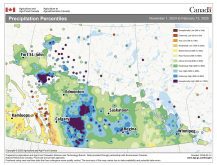This cattle market information is selected from the weekly report from Canfax, a division of the Canadian Cattlemen’s Association. More market information, analysis and statistics are available by becoming a Canfax subscriber by calling 403-275-5110 or at www.canfax.ca.
Fed prices stagnant
Western Canadian fed prices have been stuck in a $2 per hundredweight trading range for the past six weeks, with prices ranging from $150-$152 per cwt. For the end of February, prices were $3.75 per cwt. lower than the three-year average and $7.50 per cwt. lower than the five-year average.
Read Also

Canola used in only quarter of Canadian biofuel
Less than one-quarter of the biodiesel and renewable diesel used in Canada in 2024 was made from canola oil feedstock
Feedlot losses continue to pile up. Based on the Canfax Trends report, yearling steers have been profitable in only two of the past 35 months. Fed cattle prices would have to rally another $10 per cwt. to get to break-even levels.
Active trade last week saw dressed sales from $253-$254 per cwt. delivered. Cattle that traded were being scheduled for the week of March 8 and March 15 delivery.
Western Canadian fed slaughter for the week ending Feb. 20 totalled 37,678 head, six percent larger than last year. Over the past six weeks, western Canadian fed slaughter was averaging 3,960 head per week above last year.
One contributing factor is that fewer Canadian fed cattle are being exported to the United States. Based on weekly U.S. Department of Agriculture import data, since the start of the year the number of Canadian fed cattle going to the U.S. is down 20 percent compared to 2020.
In Ontario, dressed sales were reported from $240-$242 per cwt. delivered, steady to $2 per cwt. higher than two weeks ago. Cattle were being scheduled for one to three week delivery. Ontario fed prices were at their highest point since September. On a cash to cash basis, Ontario fed steers were trading at an estimated $1.33 per cwt. premium against the U.S. market compared to -$8.86 per cwt. last year.
A large number of cattle are scheduled to be released from the set-aside program this month. Despite the bigger numbers, it is expected to have limited market impact.
In the U.S., dressed sales in the north ranged from US$181-$182 per cwt., which was $1-$2 per cwt. higher than the previous week. Live sales in the south were $114 per cwt., fully steady with the previous week.
Over the past six weeks, U.S. dairy cow slaughter was up one percent compared to last year, while beef cow slaughter was up four percent.
Cow prices rise
A modest offering of non-fed cattle was reported at auction last week and prices surged higher. D2 slaughter cows saw prices more than $5 per cwt. higher than the previous week to average $86.86, and D3 cows rallied more than $4.50 per cwt. higher to average $76.31.
Dressed cow bids were also reported higher, trading from $165-$170 per cwt. delivered. Butcher bull prices eased $1 per cwt. lower than the previous week’s annual high to average $105.88 per cwt.
Alberta slaughter cows traded at a significant $8.20 and $9.50 per cwt. premium to Ontario D2s and D3s, respectively. Due to the family day holiday, western Canadian non-fed slaughter for the week ending Feb. 20 was down four percent from the previous week to 7,112 head, and year to date was 17 percent lower, totalling 52,932 head. Manageable non-fed slaughter cow supplies are anticipated.
Auction volume jumps
Warm weather flushed a large volume of feeders to auction last week, and prices firmed modestly higher. Good demand was observed for all weights, and bigger lots of quality cattle were price supportive. Calves less than 500 pounds saw prices rebound higher over the past two weeks but are expected to realign lower as supplies and quality diminish.
Middleweight calves from 500-700 lb. saw prices $1-$3 per cwt. higher than the previous week on broad-based demand. Feeders from 700-900 lb. traded mixed with steers trending unevenly steady, and similar weight heifers rallied $2.50-$5 per cwt. higher. A similar scenario was observed for large feeders heavier than 900 lb., with steers down $2.68 per cwt. and heifers trading fully steady.
Thanks to pent-up marketings during the cold snap, total weekly auction volumes surged 171 percent larger than the previous week and were 118 percent larger than a year ago. Year to date, auction volumes are up 21 percent, totalling 194,896 head.
Canadian feeder exports to the U.S. for the week ending Feb. 13 were modestly lower than the previous week and year to date volume continued to track significantly lower, totalling 6,076 head.
Strong feeder prices and good weather will encourage a large show alley again this week. Backgrounders have burned through a lot of feed to carry cattle into the new year and through the recent cold snap, so marketers are likely to be motivated.
Larger heifers have provided an opportunity to buy weight rather than feed it on, but that advantage is beginning to dry up. Strong grass and feedlot demand is anticipated this week. U.S. calves have been trading at a discount to Western Canada, and an increased volume of imported calves could be coming north.
Cutouts still high
In U.S. beef trade, production rebounded last week following weather-related slowdowns, and cut-out values kept their contra-seasonal momentum. Choice firmed by US$1.54 per cwt. to average $240.39, and Select rose by $1.32 to average $228.79 per cwt.
Total U.S. slaughter for last week was estimated six percent larger than a year ago at 666,000 head.
















